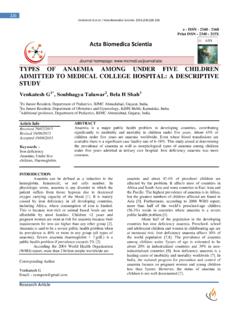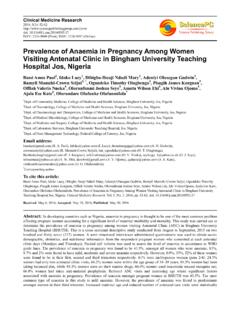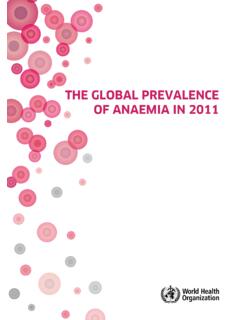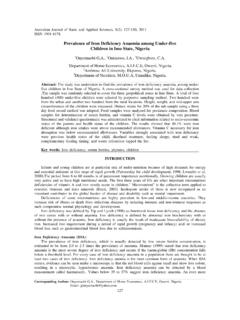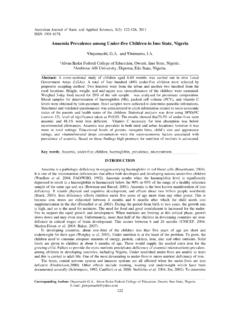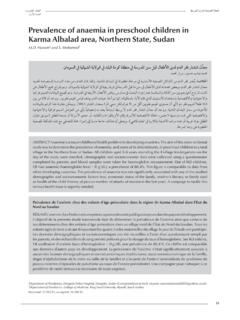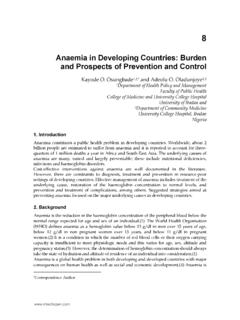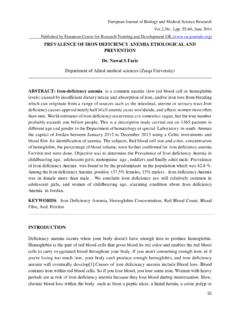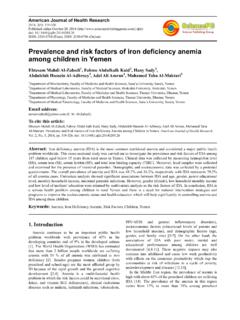Transcription of Anaemia control: Lessons from the flour fortification ...
1 Original ResearchAnaemia control : Lessons from the flour fortification programmeJ. Sadighia,*, K. Mohammadb, R. Sheikholeslamc, Amirkhanid, P. Torabie, F. Salehie, Z. AbdolahieaInstitute for Health Sciences Research, Academic Centre for Education, Culture and Research, Box 13145 483, Tehran, IranbDepartment of Epidemiology and Biostatistics, Tehran University of Medical Sciences, Tehran, IrancNutrition, Health and Development Institute, Tehran, IrandPopulation, Family and School Health Department, Ministry of Health and Medical Education, IraneNutrition Office, Ministry of Health and Medical Education, Iranarticle infoArticle history.
2 Received 21 August 2009 Received in revised form16 September 2009 Accepted 28 September 2009 Available online 14 November 2009 Keywords:AnaemiaIron deficiencyFlour fortificationWomensummaryObjectives:Anae mia is an important public health problem in Iran; therefore, a programme of flourfortification with iron was launched in two pilot provinces. The present study was conducted in January2009 to evaluate the effectiveness and process of this design:A before-and-after study was conducted to evaluate the effectiveness of the flour forti-fication programme, and the process of the programme was evaluated using a cross-sectional :To evaluate the effectiveness of the programme, blood haemoglobin and ferritin levels weremeasured in sample populations from Bushehr and Golestan provinces.
3 The target population waswomen aged 15 49 years. Iron content was measured in samples of flour and bread to evaluate the flourfortification process in these two national pilot :The total study population was 600 women from Bushehr province and 652 women fromGolestan province. Similar trends were found in the indicators of Anaemia /iron deficiency among thewomen studied in both provinces. The flour fortification programme only appears to have had a bene-ficial effect on ferritin levels (iron deficiency) in the two provinces. The prevalence of iron-deficiencyanaemia before and after the intervention did not differ significantly in either province.
4 Interestingly, theprevalence of Anaemia (low haemoglobin) was significantly higher after the intervention in women fromboth provinces. The coverage of fortified flour and bread was 90% and in Bushehr province, and 95% in Golestan province, :In areas where Anaemia is not mainly due to iron deficiency, an iron fortification programmemight decrease the prevalence of iron deficiency without affecting the prevalence of Anaemia . 2009 The Royal Society for Public Health. Published by Elsevier Ltd. All rights is a worldwide public health problem.
5 The WorldHealth Organization (WHO) estimates that Anaemia affects people worldwide , corresponding to of the humanpopulation. The highest worldwide prevalence of Anaemia is seenin Africa, but the largest number of affected individuals is found inSouth-East Asia, where 315 million individuals are than 50% of worldwide Anaemia is due to nutritional irondeficiency,2which is an important public health problem in bothdeveloping and developed to WHO mortalitydata, approximately million deaths ( of total worldwidedeaths) can be attributed to iron deficiency each Anaemia is associated with intra-uterine growthretardation, low birth weight, increased perinatal mortality, andincreased maternal morbidity and mortality.
6 Iron-deficiencyanaemia may cause cognitive deficits in young children and canaffect later motor development and school countries, severe Anaemia is the main causal factor inup to 20% of maternal ,5,6 Approximately one-fifth of casesof perinatal mortality and one-tenth of cases of maternal mortalityin developing countries are attributable to iron Anaemia is a serious public health problem in all of thecountries comprising the Eastern Mediterranean Region of WHO, aswell as the Middle East and North African Regions of the UnitedNations Children s Fund (UNICEF).
7 8 There are four basic strategies for addressing micronutrientdeficiencies: food fortification , supplementation, dietary diversifi-cation, and other public health measures ( promoting breastfeeding and controlling parasitic infestations). The present studywill focus on food fortification , which is an important strategy for*Corresponding author. Tel.: 98 21 66480804; fax: 98 21 Sadighi).Contents lists available atScienceDirectPublic Healthjournal homepage: $ see front matter 2009 The Royal Society for Public Health. Published by Elsevier Ltd.
8 All rights Health 123 (2009) 794 799improving the nutritional situation of populations. Mandatoryfortification of flour with iron has been implemented in developedcountries for many years,9 13and appears to be an effectiveapproach for combating iron ,15 Food fortification inEurope has been shown to contribute positively to the micro-nutrient status of adults16and food vehicles used around the world for iron fortifi-cation include processed cereals ( wheat and corn), salt, sugar,condiments and other processed ,8 Bread consumption ishigh in most countries of the Eastern Mediterranean Region ofWHO.
9 As such, flour fortification offers an opportunity to deliveradequate levels of iron; this strategy has been implemented ina number of countries in the Iran, Anaemia and iron deficiency are important public healthproblems. A national study conducted by the Ministry of Health andMedical Education (MOHME) and UNICEF in 1999 showed of Iranian women were anaemic according to haemoglobinlevels, were iron deficient according to serum ferritin levels,and suffered from iron-deficiency ,19 Given thatdietary data indicated that cereals provided 63% of the total energyintake in Iran, the estimated national per capita consumption ofwheat in 1993 was 178 kg/year, and consumption of bread rangedfrom 230 to 505 g/person/day,2iron fortification of wheat flour wasconsidered to be an ideal strategy for addressing iron deficiencyin 31 May 2001.
10 MOHME launched a programme to fortify flourwith iron and folic acid in Bushehr province, which was selected forthe pilot programme because of the high prevalence of iron defi-ciency and Anaemia among women of childbearing iron-fortified flour premix was produced inside Iran and included30 ppm ferrous sulphate and ppm folic is true of any programme aimed at improving health, pro-grammes involving fortification of staple foods such as wheat flourmust be subjected to systematic monitoring and evaluation todemonstrate whether or not fortification has been ,22 The authors selected several indicators for evaluating the processand effectiveness of the flour fortification programme in Iran.

